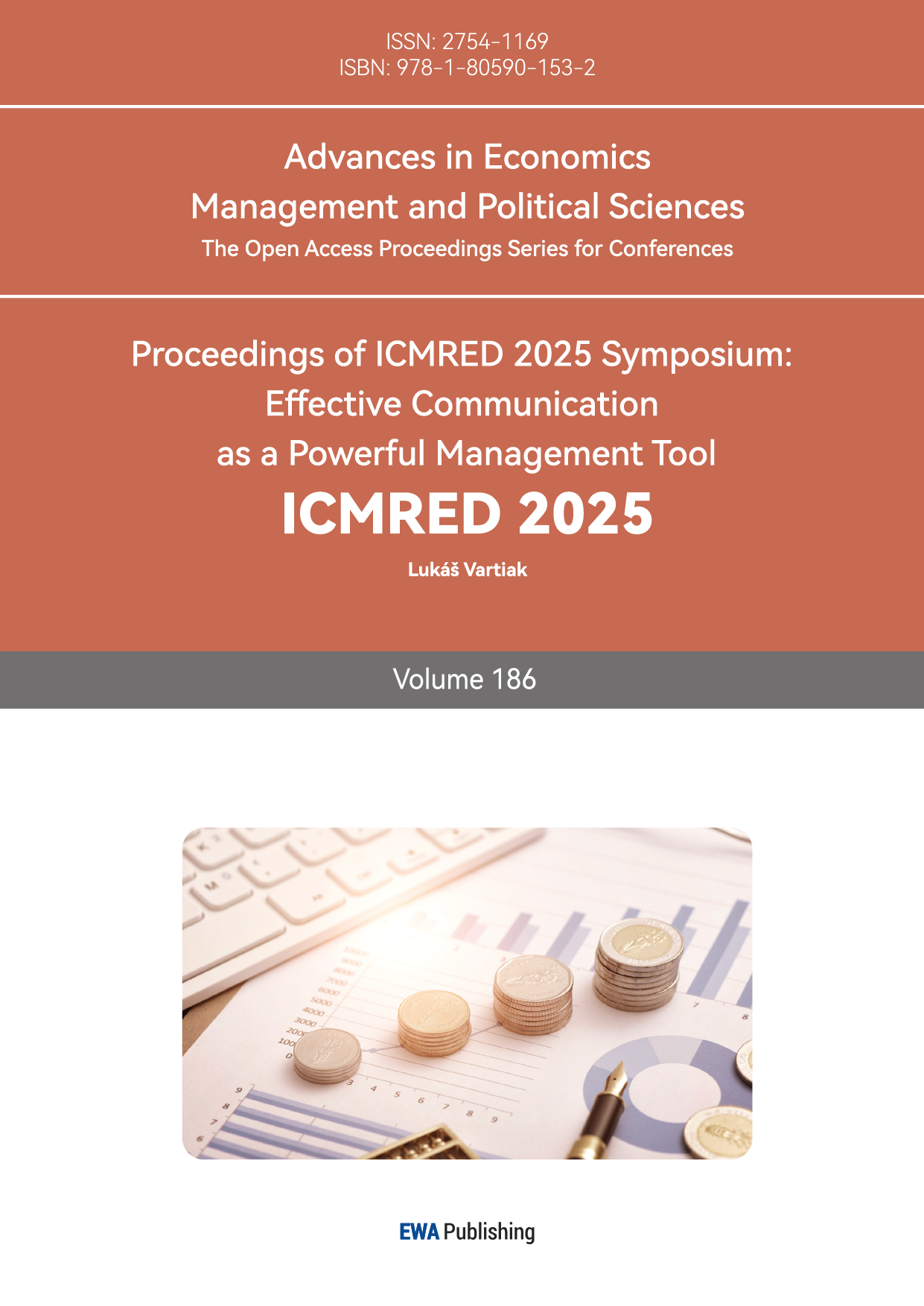References
[1]. The Tale of 2023 in 10 charts. (2023, December 17). Goldman Sachs Global Investment Research. Retrieved from https://www.gspublishing.com/content/research/en/reports/2023/12/17/7e30caa9-30d8-40b7-90c1-6ddd758de9d1.html
[2]. La Porta, R., De‐Silanes, F. L., & Shleifer, A. (2006). What works in securities laws? The Journal of Finance, 61(1), 1–32.
[3]. Liu, J., Nissim, D., & Thomas, J. (2002). Equity valuation using multiples. Journal of Accounting Research, 40(1), 135–172.
[4]. Lie, E., & Lie, H. J. (2002). Multiples used to estimate corporate value. Financial Analysts Journal, March/April, 44–54.
[5]. Henschke, S., & Homburg, C. (2009). Equity valuation using multiples: Controlling for differences between firms. SSRN Electronic Journal. https://doi.org/10.2139/ssrn.1270812
[6]. Bhojraj, S., & Lee, C. M. C. (2002). Who is my peer? A valuation-based approach to the selection of comparable firms. Journal of Accounting Research, 40(2), 407–439.
[7]. Laeven, L., & Levine, R. (2009). Bank governance, regulation and risk taking. Journal of Financial Economics, 93(2), 259–275.
[8]. Doidge, C., Karolyi, G. A., & Stulz, R. M. (2004). Why are foreign firms listed in the U.S. worth more? Journal of Financial Economics, 71(2), 205–238.
[9]. Bushman, R. M., Piotroski, J. D., & Smith, A. J. (2004). What determines corporate transparency? Journal of Accounting Research, 42(2), 207–252.
[10]. Shleifer, A., & Vishny, R. W. (1997). A survey of corporate governance. The Journal of Finance, 52(2), 737–783.
[11]. Cao, J., Duanmu, J. L., & Rodríguez, D. (2019). Journal of International Business Studies, 50(5), 763–789.
[12]. Fang, V. W., Tian, X., & Tice, S. (2014). Does stock liquidity enhance or impede firm innovation? The Journal of Finance, 69(5), 2085–2125.
[13]. Du, S., Bhattacharya, C., & Sen, S. (2010). Maximizing business returns to corporate social responsibility (CSR): The role of CSR communication. International Journal of Management Reviews, 12(1), 8–19.
[14]. Haskel, J., & Westlake, S. (2017). Capitalism without capital. Princeton University Press.
[15]. Fang, L. H., Tian, X., & Tice, S. (2014). Innovation and firm value: Evidence from the Journal of Finance. The Journal of Finance, 69(5), 2085–2125.
[16]. Aggarwal, R., Erel, I., Ferreira, M., & Matos, P. (2011). Does governance travel around the world? Evidence from institutional investors. Journal of Financial Economics, 100(1), 154–181.
Cite this article
Zhang,W. (2025). Valuation Discrepancy of Coffee Chains in the US and China: A Capital Market Perspective . Advances in Economics, Management and Political Sciences,186,56-60.
Data availability
The datasets used and/or analyzed during the current study will be available from the authors upon reasonable request.
Disclaimer/Publisher's Note
The statements, opinions and data contained in all publications are solely those of the individual author(s) and contributor(s) and not of EWA Publishing and/or the editor(s). EWA Publishing and/or the editor(s) disclaim responsibility for any injury to people or property resulting from any ideas, methods, instructions or products referred to in the content.
About volume
Volume title: Proceedings of ICMRED 2025 Symposium: Effective Communication as a Powerful Management Tool
© 2024 by the author(s). Licensee EWA Publishing, Oxford, UK. This article is an open access article distributed under the terms and
conditions of the Creative Commons Attribution (CC BY) license. Authors who
publish this series agree to the following terms:
1. Authors retain copyright and grant the series right of first publication with the work simultaneously licensed under a Creative Commons
Attribution License that allows others to share the work with an acknowledgment of the work's authorship and initial publication in this
series.
2. Authors are able to enter into separate, additional contractual arrangements for the non-exclusive distribution of the series's published
version of the work (e.g., post it to an institutional repository or publish it in a book), with an acknowledgment of its initial
publication in this series.
3. Authors are permitted and encouraged to post their work online (e.g., in institutional repositories or on their website) prior to and
during the submission process, as it can lead to productive exchanges, as well as earlier and greater citation of published work (See
Open access policy for details).
References
[1]. The Tale of 2023 in 10 charts. (2023, December 17). Goldman Sachs Global Investment Research. Retrieved from https://www.gspublishing.com/content/research/en/reports/2023/12/17/7e30caa9-30d8-40b7-90c1-6ddd758de9d1.html
[2]. La Porta, R., De‐Silanes, F. L., & Shleifer, A. (2006). What works in securities laws? The Journal of Finance, 61(1), 1–32.
[3]. Liu, J., Nissim, D., & Thomas, J. (2002). Equity valuation using multiples. Journal of Accounting Research, 40(1), 135–172.
[4]. Lie, E., & Lie, H. J. (2002). Multiples used to estimate corporate value. Financial Analysts Journal, March/April, 44–54.
[5]. Henschke, S., & Homburg, C. (2009). Equity valuation using multiples: Controlling for differences between firms. SSRN Electronic Journal. https://doi.org/10.2139/ssrn.1270812
[6]. Bhojraj, S., & Lee, C. M. C. (2002). Who is my peer? A valuation-based approach to the selection of comparable firms. Journal of Accounting Research, 40(2), 407–439.
[7]. Laeven, L., & Levine, R. (2009). Bank governance, regulation and risk taking. Journal of Financial Economics, 93(2), 259–275.
[8]. Doidge, C., Karolyi, G. A., & Stulz, R. M. (2004). Why are foreign firms listed in the U.S. worth more? Journal of Financial Economics, 71(2), 205–238.
[9]. Bushman, R. M., Piotroski, J. D., & Smith, A. J. (2004). What determines corporate transparency? Journal of Accounting Research, 42(2), 207–252.
[10]. Shleifer, A., & Vishny, R. W. (1997). A survey of corporate governance. The Journal of Finance, 52(2), 737–783.
[11]. Cao, J., Duanmu, J. L., & Rodríguez, D. (2019). Journal of International Business Studies, 50(5), 763–789.
[12]. Fang, V. W., Tian, X., & Tice, S. (2014). Does stock liquidity enhance or impede firm innovation? The Journal of Finance, 69(5), 2085–2125.
[13]. Du, S., Bhattacharya, C., & Sen, S. (2010). Maximizing business returns to corporate social responsibility (CSR): The role of CSR communication. International Journal of Management Reviews, 12(1), 8–19.
[14]. Haskel, J., & Westlake, S. (2017). Capitalism without capital. Princeton University Press.
[15]. Fang, L. H., Tian, X., & Tice, S. (2014). Innovation and firm value: Evidence from the Journal of Finance. The Journal of Finance, 69(5), 2085–2125.
[16]. Aggarwal, R., Erel, I., Ferreira, M., & Matos, P. (2011). Does governance travel around the world? Evidence from institutional investors. Journal of Financial Economics, 100(1), 154–181.









